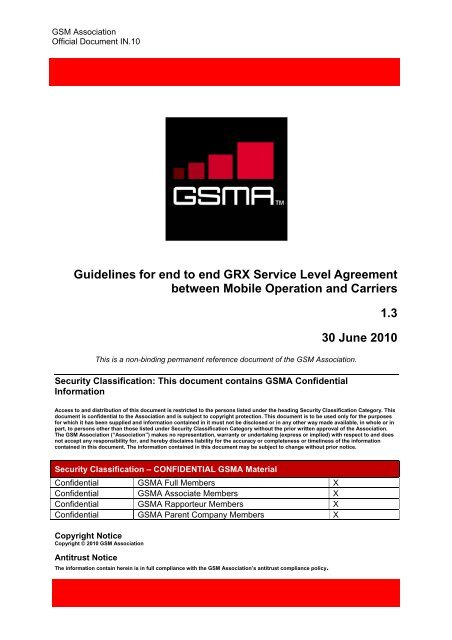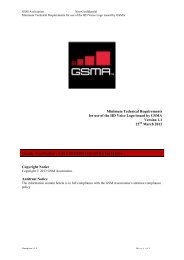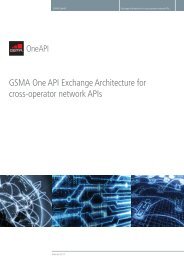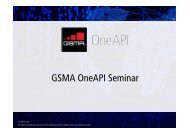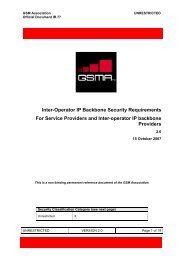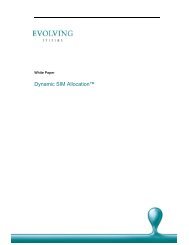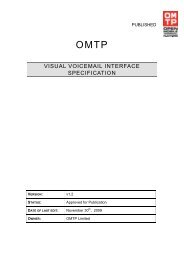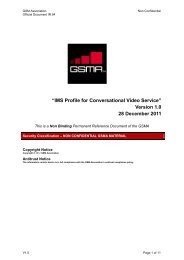Guidelines for end to end GRX Service Level Agreement ... - GSMA
Guidelines for end to end GRX Service Level Agreement ... - GSMA
Guidelines for end to end GRX Service Level Agreement ... - GSMA
Create successful ePaper yourself
Turn your PDF publications into a flip-book with our unique Google optimized e-Paper software.
GSM Association<br />
Official Document IN.10<br />
<strong>Guidelines</strong> <strong>for</strong> <strong>end</strong> <strong>to</strong> <strong>end</strong> <strong>GRX</strong> <strong>Service</strong> <strong>Level</strong> <strong>Agreement</strong><br />
between Mobile Operation and Carriers<br />
This is a non-binding permanent reference document of the GSM Association.<br />
Security Classification: This document contains <strong>GSMA</strong> Confidential<br />
In<strong>for</strong>mation<br />
1.3<br />
30 June 2010<br />
Access <strong>to</strong> and distribution of this document is restricted <strong>to</strong> the persons listed under the heading Security Classification Category. This<br />
document is confidential <strong>to</strong> the Association and is subject <strong>to</strong> copyright protection. This document is <strong>to</strong> be used only <strong>for</strong> the purposes<br />
<strong>for</strong> which it has been supplied and in<strong>for</strong>mation contained in it must not be disclosed or in any other way made available, in whole or in<br />
part, <strong>to</strong> persons other than those listed under Security Classification Category without the prior written approval of the Association.<br />
The GSM Association (“Association”) makes no representation, warranty or undertaking (express or implied) with respect <strong>to</strong> and does<br />
not accept any responsibility <strong>for</strong>, and hereby disclaims liability <strong>for</strong> the accuracy or completeness or timeliness of the in<strong>for</strong>mation<br />
contained in this document. The in<strong>for</strong>mation contained in this document may be subject <strong>to</strong> change without prior notice.<br />
Security Classification – CONFIDENTIAL <strong>GSMA</strong> Material<br />
Confidential <strong>GSMA</strong> Full Members X<br />
Confidential <strong>GSMA</strong> Associate Members X<br />
Confidential <strong>GSMA</strong> Rapporteur Members X<br />
Confidential <strong>GSMA</strong> Parent Company Members X<br />
Copyright Notice<br />
Copyright © 2010 GSM Association<br />
Antitrust Notice<br />
The in<strong>for</strong>mation contain herein is in full compliance with the GSM Association’s antitrust compliance policy.<br />
v1.3 Page 1 of 34
GSM Association<br />
Official Document IN.10<br />
Table of Contents<br />
1 Purpose ............................................................................................................. 4<br />
2 Scope and Assumption ................................................................................... 5<br />
3 <strong>Service</strong> Definition ............................................................................................. 5<br />
4 Definitions ......................................................................................................... 6<br />
4.1 Acronyms ...................................................................................................... 6<br />
5.1 End <strong>to</strong> <strong>end</strong> requirements .............................................................................. 8<br />
5.1.1 MNO <strong>to</strong> MNO Connection ............................................................................. 9<br />
5.1.2 MNO <strong>to</strong> <strong>GRX</strong> Connection ............................................................................. 9<br />
5.1.3 MNO <strong>to</strong> MNO Requirements ........................................................................ 9<br />
5.1.4 <strong>GRX</strong> <strong>to</strong> <strong>GRX</strong> SLA ......................................................................................... 9<br />
5.1.5 MNO <strong>to</strong> <strong>GRX</strong> SLA ....................................................................................... 10<br />
5.1.6 MNO <strong>to</strong> MNO Requirements ...................................................................... 10<br />
5.1.7 GPRS <strong>end</strong>-<strong>to</strong>-<strong>end</strong> requirements ................................................................. 11<br />
5.1.8 <strong>GRX</strong> <strong>end</strong>-<strong>to</strong>-<strong>end</strong> requirements ................................................................... 11<br />
6 Technical Characteristics of the Connection .............................................. 12<br />
6.1 End <strong>to</strong> <strong>end</strong> Demarcation Points .................................................................. 12<br />
6.2 <strong>GRX</strong> <strong>end</strong> <strong>to</strong> <strong>end</strong> .......................................................................................... 13<br />
6.2.1 Scenario 1 – Local Loop provided by the Mobile Opera<strong>to</strong>r, or the Mobile Opera<strong>to</strong>r<br />
chooses <strong>to</strong> use IPSec Access across the Internet <strong>to</strong> access the <strong>GRX</strong> Provider .... 13<br />
6.2.2 Scenario 2- Local Loop provided by the <strong>GRX</strong> Provider .............................. 13<br />
6.2.3 Scenario 3 - Local Loop provided by the <strong>GRX</strong> Provider. Mobile Opera<strong>to</strong>r refuses<br />
access <strong>to</strong> the Border Gateway ............................................................................... 14<br />
6.2.4 Worst Case - Both MNOs not agreeing <strong>to</strong> measurement/Moni<strong>to</strong>ring local Tail, the<br />
<strong>GRX</strong> End-<strong>to</strong>-End Demarcation = Stages 3+4+3..................................................... 14<br />
6.2.5 Best Case- Both <strong>GRX</strong>s Provide ‘managed’ CPE End <strong>to</strong> End = Stage 9 .. 15<br />
6.3 Definition of Measurement Points ............................................................... 16<br />
7 <strong>Service</strong> Quality Parameters – KPIs ............................................................... 16<br />
7.1 MTRS- Maximum Time <strong>to</strong> Res<strong>to</strong>re the <strong>Service</strong> .......................................... 17<br />
7.1.1 General ....................................................................................................... 17<br />
7.1.2 Critical Errors .............................................................................................. 17<br />
7.1.3 Severe Errors ............................................................................................. 17<br />
7.1.4 Warning Errors ........................................................................................... 17<br />
7.2 Delay .......................................................................................................... 17<br />
7.3 Jitter (= Delay variation = Standard Deviation of Delay) ............................. 18<br />
7.4 Packet Loss ................................................................................................ 18<br />
7.5 <strong>GRX</strong> Access Availability ............................................................................. 18<br />
7.5.1 Definition ..................................................................................................... 18<br />
7.5.2 Measurement Method ................................................................................. 18<br />
7.5.3 Calculation Method ..................................................................................... 18<br />
7.6 DNS Lookup Time ...................................................................................... 19<br />
7.7 <strong>Service</strong> Availability ...................................................................................... 19<br />
7.7.1 Availability of the <strong>Service</strong> per Destination................................................... 20<br />
7.8 DNS Availability .......................................................................................... 21<br />
7.8.1 Definition ..................................................................................................... 21<br />
7.8.2 Measurement Method ................................................................................. 21<br />
7.8.3 Calculation Method ..................................................................................... 21<br />
7.9 PDP Context Creation delivery success ratio ............................................. 22<br />
7.9.1 Definition ..................................................................................................... 22<br />
7.9.2 Measurement Method ................................................................................. 22<br />
7.9.3 Calculation Method ..................................................................................... 22<br />
v1.3 Page 2 of 34
GSM Association<br />
Official Document IN.10<br />
7.9.4 General rule: ............................................................................................... 22<br />
9.1 Qualifying Claims ........................................................................................ 24<br />
9.2 <strong>Service</strong> Credit <strong>Level</strong> ................................................................................... 24<br />
9.3 <strong>Service</strong> Credit Claim Procedure ................................................................. 24<br />
10 Controlled Accessibility Policy ..................................................................... 24<br />
10.1 Direct Accessibility ...................................................................................... 25<br />
10.2 Accessibility ................................................................................................ 25<br />
11 Cus<strong>to</strong>mer Care ............................................................................................... 25<br />
12 Operation & Maintenance – Fault Management .......................................... 25<br />
12.1 Introduction ................................................................................................. 25<br />
12.2 Central Notification Addresses ................................................................... 25<br />
12.3 Fault Classification ..................................................................................... 26<br />
12.4 Fault Reporting Procedures ........................................................................ 26<br />
12.4.1 Fault Reporting by the Mobile Opera<strong>to</strong>r ..................................................... 26<br />
12.4.2 Fault reporting by the Carrier ...................................................................... 27<br />
13 Fault Resolution ............................................................................................. 27<br />
13.1 Escalation Procedure ................................................................................. 27<br />
13.2 Official Status In<strong>for</strong>mation .......................................................................... 28<br />
13.3 Fault Clearance Procedures ....................................................................... 28<br />
13.4 Duration of a Fault ...................................................................................... 28<br />
13.5 Fault Handling and Per<strong>for</strong>mance Reporting ............................................... 29<br />
13.5.1 General provisions ...................................................................................... 29<br />
13.5.2 Monthly Fault Report .................................................................................. 29<br />
13.5.3 Monthly Review Fault Report ..................................................................... 30<br />
13.5.4 Monthly Traffic Report ................................................................................ 30<br />
13.5.5 Monthly Quality of <strong>Service</strong> Report (= Monthly Per<strong>for</strong>mance Report = MPR)30<br />
14.1 <strong>Service</strong> Management .................................................................................. 31<br />
14.2 Traffic Management .................................................................................... 31<br />
14.3 Maintenance Operations Management ...................................................... 31<br />
14.3.1 Planned Outages ........................................................................................ 31<br />
14.3.2 Parameter change notification & contact points update ............................. 32<br />
14.3.3 Connection between Carrier`s system and the Mobile Opera<strong>to</strong>r`s system 32<br />
14.3.4 Communication ........................................................................................... 32<br />
15 SLA Review ..................................................................................................... 32<br />
16 ANNEX A - SERVICE CREDIT LEVEL ........................................................... 32<br />
17 ANNEX B – Monthly Report ........................................................................... 33<br />
18 ANNEX C – Priority 1, 2 & 3 Destinations .................................................... 33<br />
19 DOCUMENT MANAGEMENT ......................................................................... 33<br />
v1.3 Page 3 of 34
GSM Association<br />
Official Document IN.10<br />
1 PURPOSE<br />
This document is int<strong>end</strong>ed <strong>to</strong> provide Mobile Opera<strong>to</strong>rs and <strong>GRX</strong> Providers with the<br />
minimum requirements <strong>to</strong> be included in the implementation of bilateral <strong>Service</strong> <strong>Level</strong><br />
<strong>Agreement</strong>s (“SLA”) related <strong>to</strong> the <strong>GRX</strong> <strong>Service</strong> agreed by between Mobile Opera<strong>to</strong>rs and<br />
<strong>GRX</strong>.<br />
In support of these quality principles such recomm<strong>end</strong>ed <strong>GRX</strong> <strong>Service</strong> <strong>Level</strong> <strong>Agreement</strong> can<br />
be used alongside that of the Roaming SLA.<br />
According <strong>to</strong> these <strong>Guidelines</strong>, a <strong>GRX</strong> SLA may include the following areas:<br />
• <strong>Service</strong> Definition<br />
• Scope and Assumption<br />
• Definitions<br />
• Quality of <strong>Service</strong><br />
• Qualifying faults<br />
• <strong>Service</strong> Credits<br />
• <strong>Service</strong> Credits claim procedures<br />
• Carrier and Mobile Opera<strong>to</strong>r commitment <strong>to</strong> <strong>end</strong>-<strong>to</strong>-<strong>end</strong> quality<br />
• Adding SLAs <strong>to</strong> the peering model.<br />
• Implementation of peering at a second peering point/Redundancy and per<strong>for</strong>mance<br />
improvement<br />
• Cus<strong>to</strong>mer Care<br />
• Operation and Maintenance - Fault Management<br />
• Operation and Maintenance - Non Fault Management<br />
• SLA Review<br />
Additionally, this document explains the practical <strong>end</strong>-<strong>to</strong>-<strong>end</strong> QoS meaning in <strong>GRX</strong> offering<br />
and presents a guideline <strong>for</strong> <strong>GRX</strong> Providers on the major aspects of the <strong>GRX</strong> <strong>end</strong>-<strong>to</strong>-<strong>end</strong><br />
QoS provisioning. <strong>GRX</strong> Providers and Mobile Opera<strong>to</strong>rs can use this document as a<br />
reference or educational material on <strong>GRX</strong> QoS related question.<br />
v1.3 Page 4 of 34
GSM Association<br />
Official Document IN.10<br />
2 SCOPE AND ASSUMPTION<br />
This document provides a detailed technical description of <strong>end</strong>-<strong>to</strong>-<strong>end</strong> Quality of <strong>Service</strong><br />
(QoS), including related terms definition, initial requirements, provisioning and measurement<br />
methods, and SLA general aspects. This document covers <strong>GRX</strong> <strong>end</strong>-<strong>to</strong>-<strong>end</strong> QoS.<br />
To place an agreement <strong>for</strong> <strong>GRX</strong> service between <strong>GRX</strong> Provider and Mobile Opera<strong>to</strong>r the<br />
AA.80 (<strong>Agreement</strong> <strong>for</strong> IP packet exchange services including IPX transport SLA) can be<br />
used as a template <strong>for</strong>. It provides the agreement <strong>for</strong> IPX transport service including the<br />
transport SLA. <strong>GRX</strong> service refers <strong>to</strong> the same requirements as transport traffic class<br />
“background” QoS described at the AA.80. In addition the following KPIs should be included<br />
in the AA.80 at the KPI section:<br />
• DNS lookup time<br />
• PDP context creation delivery success ratio<br />
• DNS availability<br />
This document delineates general requirements <strong>for</strong> <strong>GRX</strong> Providers and GPRS/UMTS<br />
opera<strong>to</strong>rs related <strong>to</strong> <strong>GRX</strong> <strong>end</strong>-<strong>to</strong>-<strong>end</strong> service provisioning. Options <strong>for</strong> Mobile Opera<strong>to</strong>rs’<br />
<strong>GRX</strong> Providers’ internal QoS mechanism implementations are also provided. Each <strong>GRX</strong><br />
Provider and Mobile Opera<strong>to</strong>r is free <strong>to</strong> choose any internal QoS and transport technology<br />
as long as this meets the general requirements specified in this document.<br />
This document also assumes that the well-known QoS terminology is unders<strong>to</strong>od. The<br />
concept and definitions introduced in this document are relevant only <strong>to</strong> <strong>GRX</strong> <strong>end</strong>-<strong>to</strong>-<strong>end</strong><br />
QoS.<br />
The following circumstances will be considered out of scope:<br />
• A fault in, or any other problem associated with, Cus<strong>to</strong>mer-supplied power, any<br />
Cus<strong>to</strong>mer Equipment, non-maintained structured cabling.<br />
• <strong>Service</strong> suspension in accordance with the terms of the SLA.<br />
• All delay, jitter and that kind of values, as well DSCP bit combinations (and traffic<br />
classes) may be referred and used as examples in this document, but are introduced<br />
and updated in IR.34<br />
3 SERVICE DEFINITION<br />
The requested service may be described by:<br />
"Providing Internet pro<strong>to</strong>col connectivity between GSM networks supporting IP roaming and<br />
interworking possibilities”<br />
Classic roaming is defined between GSM networks, i.e. between two connected GSM<br />
networks, and several roaming relationships exist simultaneously. Similar we will define<br />
GPRS roaming <strong>to</strong> take place between two GSM networks supporting GPRS (not only<br />
between GPRS networks, if we also look <strong>for</strong>ward <strong>to</strong> <strong>for</strong> example, UMTS)<br />
v1.3 Page 5 of 34
GSM Association<br />
Official Document IN.10<br />
The <strong>Service</strong> <strong>Level</strong> <strong>Agreement</strong>s (SLA) shall cover all aspects of IP connectivity. Especially<br />
technical data describing the per<strong>for</strong>mance of the connections between the MNO and each of<br />
its’ roaming partners must be fixed.<br />
4 DEFINITIONS<br />
This section should include the definition of terms related <strong>to</strong> the quality parameters as based<br />
on the definitions below:<br />
<strong>Agreement</strong> = The <strong>Service</strong> <strong>Agreement</strong> between the Carrier and the Mobile Opera<strong>to</strong>r <strong>for</strong> the<br />
provision of services.<br />
Direct Termination: When the traffic is routed from the originated network <strong>to</strong>wards the<br />
destination network using only one Carrier single network<br />
<strong>GRX</strong> TRAFFIC: IP traffic carried over the <strong>GRX</strong> network<br />
Month = from the 1st day of the cal<strong>end</strong>ar month 0:00:00 a.m. <strong>to</strong> the last day of cal<strong>end</strong>ar<br />
month 11:59:59 p.m.<br />
MTRS = Maximum time <strong>to</strong> res<strong>to</strong>re the service in case of network or service errors/faults:<br />
The severity of errors may dep<strong>end</strong> upon the network elements/services involved in the<br />
malfunctioning. In clause 7.1 a more detailed definition can be found.<br />
<strong>Service</strong> Credit = the amount that the Mobile Opera<strong>to</strong>r or <strong>GRX</strong> Provider is eligible <strong>for</strong> when<br />
submitting a qualifying claim with regards <strong>to</strong> QoS commitments.<br />
SLA = quality <strong>Service</strong> <strong>Level</strong> <strong>Agreement</strong><br />
4.1 Acronyms<br />
ATM Asynchronous Transfer Mode<br />
BG Border Gateway<br />
BGP Border Gateway Pro<strong>to</strong>col<br />
CB-WFQ Class Based Weighted Fair Queuing<br />
CIX Commercial Internet exchange<br />
CoS Class of <strong>Service</strong><br />
DiffServ Differentiated <strong>Service</strong>s<br />
DNS Domain Name Network<br />
DP Demarcation Point<br />
DSCP Differentiated <strong>Service</strong>s Code Point<br />
v1.3 Page 6 of 34
GSM Association<br />
Official Document IN.10<br />
DoS Denial of <strong>Service</strong><br />
GPRS General Packet Radio <strong>Service</strong> (often referred as mobile 2.5G)<br />
<strong>GRX</strong> GPRS Roaming eXchange<br />
GTP GPRS Tunneling Pro<strong>to</strong>col<br />
ICN Intra-Connect Network<br />
MNO Mobile Network Opera<strong>to</strong>r<br />
MPLS Multi Pro<strong>to</strong>col Label Switching<br />
MPR Monthly Per<strong>for</strong>mance Report<br />
MTTR Mean Time To Res<strong>to</strong>re<br />
PE Provider Edge<br />
PHB Per Hop Behavior<br />
PLMN Public Land Mobile Network<br />
PX Provider eXchange<br />
QoS Quality of <strong>Service</strong><br />
RED Random Early Detect<br />
RP Reference Point<br />
RSVP Resource reSerVation Pro<strong>to</strong>col<br />
SLA <strong>Service</strong> <strong>Level</strong> <strong>Agreement</strong><br />
SMTP Simple Mail Transfer Pro<strong>to</strong>col<br />
TOS Type of <strong>Service</strong><br />
UMTS Universal Mobile Telecommunications Network<br />
VLAN Virtual LAN (Local Access Network)<br />
VPN Virtual Private Network<br />
5 QUALITY OF SERVICE<br />
At a high level of abstraction, “Quality of <strong>Service</strong>” refers <strong>to</strong> a set of service requirements <strong>to</strong><br />
be met by the network while transporting a connection or flow and the ability <strong>to</strong> deliver<br />
network services according <strong>to</strong> the parameters specified in a SLA. “Quality” is characterized<br />
v1.3 Page 7 of 34
GSM Association<br />
Official Document IN.10<br />
by service availability, delay, jitter and packet loss ratio. At this level, QoS is a set of service<br />
quality commitments that <strong>GRX</strong> Providers and Mobile Opera<strong>to</strong>rs will offer <strong>to</strong> their cus<strong>to</strong>mers.<br />
The QoS parameters and requirements are discussed later in this document.<br />
QoS Parameters <strong>Service</strong> Availability, Jitter, Packet Loss and Roundtrip Delay are defined in<br />
clause 7, <strong>Service</strong> Quality commitments.<br />
THE VALUES FOR <strong>GRX</strong> END TO END QOS ARE BASED ON MEASUREMENT 8 OR<br />
3+4+5 but real <strong>end</strong> <strong>to</strong> <strong>end</strong> QoS needs <strong>to</strong> be moni<strong>to</strong>red between Border Gateway routers of<br />
the Mobile Opera<strong>to</strong>rs<br />
Measurement Owner Action Required<br />
1 End user <strong>to</strong> BG MNO A MNO SLA<br />
2 BG <strong>to</strong> <strong>GRX</strong>1 edge device MNO A MNO SLA<br />
3 <strong>GRX</strong>1 edge <strong>to</strong> peering point <strong>GRX</strong>1 <strong>GRX</strong> SLA<br />
4 Peering point port <strong>to</strong> peering point Peering Peering point SLA<br />
port<br />
point<br />
5 Peering point <strong>to</strong> <strong>GRX</strong>2 edge device <strong>GRX</strong>2 <strong>GRX</strong> SLA –note, this example includes II<br />
and CPE<br />
6 CPE <strong>to</strong> <strong>end</strong> user MNO B MNO SLA<br />
7 End user <strong>to</strong> <strong>end</strong> user MNO A and<br />
B<br />
MNO SLA<br />
8 <strong>GRX</strong> edge <strong>to</strong> <strong>GRX</strong> edge <strong>GRX</strong>1 and 2 Intra <strong>GRX</strong> SLA<br />
1 2 3 4<br />
5<br />
MNO MNO A<br />
Provider<br />
Edge<br />
PCU<br />
IP IP<br />
network<br />
Router<br />
<strong>GRX</strong>1 <strong>GRX</strong>2 <strong>GRX</strong>2<br />
Border Border<br />
Peering<br />
Gateway<br />
Exchange Exchange<br />
DM3 Serial port<br />
5.1 End <strong>to</strong> <strong>end</strong> requirements<br />
DM2 Serial port<br />
8<br />
Provider<br />
Edge<br />
Router<br />
Local Local<br />
tail<br />
v1.3 Page 8 of 34<br />
CPE<br />
6<br />
MNO MNO B<br />
IP IP<br />
network<br />
BG<br />
Server<br />
DM1 Ethernet port<br />
The objective of this document is <strong>to</strong> detail how the <strong>GRX</strong> Providers and mobile industry will<br />
achieve a full <strong>end</strong> <strong>to</strong> <strong>end</strong> SLA on the <strong>GRX</strong> <strong>to</strong> allow us <strong>to</strong> achieve overall latency and QoS<br />
targets <strong>to</strong> support classes of services e.g. conversational, in line with the QoS requirements<br />
specified in the IR34.<br />
The <strong>end</strong>-<strong>to</strong>-<strong>end</strong> path in a GPRS connection is a very long path made up of many<br />
components of a great diversity. Following drawing is only an illustration of what could be in<br />
the path:
GSM Association<br />
Official Document IN.10<br />
PCU<br />
MNO A<br />
IP<br />
network<br />
Border<br />
Gateway<br />
<strong>GRX</strong>1 <strong>GRX</strong>2<br />
Peering<br />
Exchange<br />
Edge<br />
router<br />
Local<br />
tail<br />
v1.3 Page 9 of 34<br />
CPE<br />
MNO B<br />
IP<br />
network<br />
Quality requirements are often first stated from the user’s point of view, e.g. what is the<br />
maximum allowed latency between the 2 <strong>end</strong> terminals. In this document, unless otherwise<br />
specified, <strong>end</strong>-<strong>to</strong>-<strong>end</strong> will mean BG <strong>to</strong> BG<br />
It should be noted, that the <strong>GRX</strong> and the MNO have a collective role in ensuring this <strong>end</strong>-<strong>to</strong><strong>end</strong><br />
SLA commitment, and the objective of this document is <strong>to</strong> detail the responsibilities of all<br />
parties in this chain.<br />
A number of <strong>end</strong>-<strong>to</strong>-<strong>end</strong> <strong>GRX</strong> connectivity possibilities are possible and these need <strong>to</strong> be<br />
considered when considering the impact on the <strong>end</strong>-<strong>to</strong>-<strong>end</strong> SLA.<br />
5.1.1 MNO <strong>to</strong> MNO Connection<br />
Originating and terminating MNO connected <strong>to</strong> the same <strong>GRX</strong>;<br />
Originating and terminating MNO connected <strong>to</strong> different <strong>GRX</strong>’s (maximum of two hops<br />
required between <strong>GRX</strong>);<br />
5.1.2 MNO <strong>to</strong> <strong>GRX</strong> Connection<br />
Originating/terminating MNO connected <strong>GRX</strong> using Managed Connection (local loop and CE<br />
router provided by <strong>GRX</strong> Provider);<br />
Originating/terminating MNO connected <strong>to</strong> <strong>GRX</strong> using an Un-Managed Connection (local<br />
loop provided by MNO);<br />
Originating/terminating MNO connected <strong>to</strong> <strong>GRX</strong> using IPSec connection.<br />
5.1.3 MNO <strong>to</strong> MNO Requirements<br />
It is expected also that MNO’s shall define and agree minimum <strong>GRX</strong> connectivity<br />
requirements within their Roaming <strong>Agreement</strong>s.<br />
5.1.4 <strong>GRX</strong> <strong>to</strong> <strong>GRX</strong> SLA<br />
Where the originating and terminating MNO use the same SLA, the <strong>GRX</strong> Provider will be<br />
responsible <strong>for</strong> the <strong>end</strong>-<strong>to</strong>-<strong>end</strong> SLA between the MNO’s, providing the MNO satisfies its<br />
obligations as specified in this SLA.<br />
Where the <strong>GRX</strong> cus<strong>to</strong>mers are connected <strong>to</strong> different <strong>GRX</strong> Providers, each <strong>GRX</strong> shall take<br />
responsibility <strong>for</strong> the other <strong>GRX</strong>’s it is connected <strong>to</strong>. When the <strong>GRX</strong> SLA is defined and<br />
agreed, it is expected that the same SLA will then be agreed by all the <strong>GRX</strong> Providers, so<br />
we achieve a full back <strong>to</strong> back SLA with all <strong>GRX</strong> Providers, providing the MNO satisfy<br />
their obligations as specified in this SLA.<br />
BG<br />
Server
GSM Association<br />
Official Document IN.10<br />
The <strong>GRX</strong> Provider that is connected <strong>to</strong> each MNO is then expected <strong>to</strong> take full responsibility<br />
<strong>for</strong> subsequent qualified faults or service failures that may occur on other <strong>GRX</strong>’s that take<br />
place between it and the destination MNO, providing the MNO satisfies its obligations as<br />
specified in this SLA.<br />
<strong>GRX</strong> Providers will also be expected <strong>to</strong> agree on the overall latency and QoS requirements<br />
<strong>to</strong> allow the overall <strong>end</strong> <strong>to</strong> <strong>end</strong> QoS <strong>to</strong> be achieved, in accordance with the latency, jitter and<br />
availability per<strong>for</strong>mance specified in the IR34.<br />
5.1.5 MNO <strong>to</strong> <strong>GRX</strong> SLA<br />
Where the originating and terminating MNO’s are connected <strong>to</strong> a <strong>GRX</strong> using a Managed<br />
Connection (i.e local loop and CE router provided by <strong>GRX</strong> Provider), then the <strong>GRX</strong>’s are<br />
expected <strong>to</strong> take full <strong>end</strong> <strong>to</strong> <strong>end</strong> responsibility <strong>for</strong> the traffic, in accordance with the <strong>GRX</strong> <strong>to</strong><br />
<strong>GRX</strong> SLA requirements defined above;<br />
Where the originating/terminating MNO is connected <strong>to</strong> <strong>GRX</strong> using an un-managed<br />
connection (local loop provided by MNO), then the MNO who is connected using an unmanaged<br />
connection will be required <strong>to</strong> provide an SLA <strong>to</strong> the <strong>GRX</strong> Provider on the Local<br />
Loop connection, as follows when there is a quality degradation:<br />
• Availability - [Specify Target in line with final IR34]<br />
• Jitter - [Specify Target in line with final IR34]<br />
• Roundtrip delay - [Specify Target in line with final IR34]<br />
• Packet Loss - [Specify Target in line with final IR34]<br />
In the case of qualifying network faults affecting connectivity under the control of the <strong>GRX</strong><br />
Provider, the <strong>GRX</strong> has <strong>to</strong> take responsibility of the management of the failure until the point<br />
of demarcation.<br />
5.1.6 MNO <strong>to</strong> MNO Requirements<br />
The Roaming agreements will be modified <strong>to</strong> contain minimum levels of commitment on the<br />
MNO, <strong>to</strong> ensure good cus<strong>to</strong>mer experience whilst roaming. These minimum commitments<br />
shall include;<br />
MNO shall ensure that it has geographically redundant connections <strong>to</strong> one or more <strong>GRX</strong><br />
Providers;<br />
MNO shall ensure that sufficient capacity is provided at all times <strong>to</strong> support data roaming<br />
volumes of roaming cus<strong>to</strong>mer on their network. MNO shall ensure that no more than 80%<br />
average utilisation in peak hour of the <strong>GRX</strong> is achieved at any time; <strong>GRX</strong>’s (or alternatively<br />
the responsible of line) will arrange <strong>for</strong>ecasts of Local Loop early enough <strong>to</strong> ensure the<br />
upgrades do not introduce delays.<br />
Capacity upgrades should be achieved with the MNO’s <strong>GRX</strong> Provider in no less than XX<br />
working days from the MNO being aware that the above capacity requirements are not being<br />
met whenever there is no need <strong>for</strong> change of connection type [To be agreed between<br />
parties]<br />
The MNO <strong>to</strong> MNO commitment in the SLA shall not reduce the <strong>GRX</strong>’s commitment <strong>to</strong><br />
manage the <strong>end</strong> <strong>to</strong> <strong>end</strong> per<strong>for</strong>mance of the <strong>GRX</strong>. The <strong>GRX</strong>’s are expected <strong>to</strong> take<br />
v1.3 Page 10 of 34
GSM Association<br />
Official Document IN.10<br />
responsibility <strong>for</strong> all faults that are brought <strong>to</strong> their attention by its cus<strong>to</strong>mers, and <strong>to</strong> seek<br />
resolution of these faults in accordance with the <strong>GSMA</strong> SLA.<br />
5.1.7 GPRS <strong>end</strong>-<strong>to</strong>-<strong>end</strong> requirements<br />
The GPRS <strong>end</strong>-<strong>to</strong>-<strong>end</strong> QoS recomm<strong>end</strong>ations (BG-<strong>to</strong>-BG) are defined by <strong>GSMA</strong> IR.34<br />
document<br />
The SLA parameters in the GPRS roaming agreement may have different values; they are<br />
bilaterally agreed between GPRS opera<strong>to</strong>rs.<br />
There are differentiated service requirements in 3G, so every requirement is specific <strong>to</strong> a<br />
Class of <strong>Service</strong>.<br />
5.1.8 <strong>GRX</strong> <strong>end</strong>-<strong>to</strong>-<strong>end</strong> requirements<br />
<strong>GRX</strong> <strong>end</strong>-<strong>to</strong>- <strong>end</strong> requirements (<strong>GRX</strong> access point <strong>to</strong> <strong>GRX</strong> access point) are derived from<br />
the GPRS <strong>end</strong>- <strong>to</strong>- <strong>end</strong> requirements. But several fac<strong>to</strong>rs influence significantly the extent <strong>to</strong><br />
how much <strong>GRX</strong> <strong>end</strong>-<strong>to</strong>-<strong>end</strong> path reflects GPRS <strong>end</strong>-<strong>to</strong>-<strong>end</strong> path.<br />
In most cases, a local tail connects the MNO’s network <strong>to</strong> the <strong>GRX</strong> backbone. For a good<br />
understanding of the importance of the local tail, the issues that are linked <strong>to</strong> it will be<br />
worked out in some more detail.<br />
1) MNO connects with a local tail <strong>to</strong> the <strong>GRX</strong> edge<br />
router in the <strong>GRX</strong> POP<br />
MNO<br />
GPRS<br />
network<br />
Border<br />
Gateway<br />
Local<br />
tail<br />
Edge<br />
router<br />
<strong>GRX</strong><br />
2) MNO connects <strong>to</strong> a <strong>GRX</strong> managed CPE at his<br />
promises, the CPE is connected with a local tail <strong>to</strong> the<br />
<strong>GRX</strong> edge router in the <strong>GRX</strong> POP<br />
MNO<br />
GPRS<br />
network<br />
Border CPE<br />
Gateway<br />
In both cases, there is a local tail between the GPRS network and the <strong>GRX</strong> backbone.<br />
The impact of the local tail on the <strong>end</strong>-<strong>to</strong>-<strong>end</strong> per<strong>for</strong>mance can hardly be overestimated:<br />
v1.3 Page 11 of 34<br />
Local<br />
tail<br />
Edge<br />
router<br />
• It is often the bottleneck in terms of bandwidth and as such the determining fac<strong>to</strong>r <strong>for</strong><br />
the quality of the BG <strong>to</strong> BG path<br />
• It is often sized in the agreement between MNO and <strong>GRX</strong>. While the <strong>GRX</strong> backbone<br />
dimensioning is obviously, the <strong>GRX</strong>’s own decision, the local tail is decided by MNO<br />
and/or <strong>GRX</strong>. Obviously, if one party decides on the dimensioning, the other party can<br />
not be held responsible <strong>for</strong> quality issues due <strong>to</strong> insufficient dimensioning Moreover,<br />
<strong>GRX</strong> 1 is limited in his possibilities <strong>to</strong> offer guarantees on BG <strong>to</strong> BG quality levels <strong>to</strong><br />
MNO A if MNO B decides <strong>to</strong> have a local tail with <strong>GRX</strong> 2 that is not sufficiently sized.<br />
• Another very important fac<strong>to</strong>r is the nature of the local tail. Often two options are<br />
encountered<br />
o Physical link. Being some kind of a dedicated L1 or L2 link (SDH, FR, …)<br />
o Tunnel through the internet<br />
<strong>GRX</strong>
GSM Association<br />
Official Document IN.10<br />
While quality can be specified and guaranteed easily <strong>for</strong> a physical link, this is<br />
often different <strong>for</strong> a tunnel through Internet.<br />
As a rule of thumb, it is often said that no quality parameters, such as Delay or Packet loss,<br />
can be guaranteed on a link that has a continuous load of more than 60 <strong>to</strong> 70 % of the<br />
capacity.<br />
A local tail must be included in the quality parameters; this is a choice of the <strong>GRX</strong> and the<br />
MNO.<br />
If differentiated services are provided by any of the <strong>GRX</strong> Providers, than every cell in the<br />
above table is split in<strong>to</strong> several cells (one cell per CoS).<br />
In order <strong>to</strong> provide the <strong>GRX</strong> <strong>end</strong>-<strong>to</strong>-<strong>end</strong> QoS compliant with these requirements both <strong>GRX</strong><br />
Providers and Mobile Opera<strong>to</strong>rs shall agree on QoS parameters definition and the <strong>end</strong>-<strong>to</strong><strong>end</strong><br />
QoS Measurements Method. A single SLA built upon the Back-<strong>to</strong>-Back SLA between<br />
<strong>GRX</strong> Providers must be signed between MNOS and <strong>GRX</strong> Providers <strong>for</strong> guarantee of the<br />
commitments on the <strong>GRX</strong> <strong>end</strong>-<strong>to</strong>-<strong>end</strong> QoS defined in this section. All these areas are<br />
covered in the respective sections in this document.<br />
6 TECHNICAL CHARACTERISTICS OF THE CONNECTION<br />
The technical data of the requested service are defined in this chapter. We stress exactness,<br />
i.e. we try <strong>to</strong> define the connection characteristics or link characteristics in such detail that no<br />
"open points" remain. We do this by stating a set of parameters, which - taken <strong>to</strong>gether -<br />
define the connectivity service from a technical point of view.<br />
All service parameter definitions are in terms of the Internet Pro<strong>to</strong>col. That means that all<br />
service parameters are defined using IP packets or are related <strong>to</strong> IP packets or IP packet<br />
transfer.<br />
These parameters are: Delay, Jitter (=Delay variation), Packet Loss and Availability.<br />
Each parameter shall be described in a dedicated section. Be<strong>for</strong>e doing so, we introduce<br />
"Demarcation Points" which will be used <strong>to</strong> define context, i.e. locate points in the<br />
communication link, where measurements will be done.<br />
6.1 End <strong>to</strong> <strong>end</strong> Demarcation Points<br />
This document assumes that any two MNO networks are interconnected by at most two<br />
<strong>GRX</strong> networks, as specified in IR.34, meaning there is no transit <strong>GRX</strong> service.<br />
A very important concept is the “demarcation point”.<br />
The demarcation point of the <strong>GRX</strong> is the point where the responsibility of the <strong>GRX</strong> Provider<br />
s<strong>to</strong>ps. It could also be called responsibility boundary.<br />
The demarcation point is also the point up <strong>to</strong> where the initial responsibility of the <strong>GRX</strong> <strong>end</strong>s<br />
<strong>for</strong> SLA purposes.<br />
v1.3 Page 12 of 34
GSM Association<br />
Official Document IN.10<br />
6.1.1 <strong>GRX</strong> <strong>end</strong> <strong>to</strong> <strong>end</strong><br />
In the case of a <strong>GRX</strong> Provider supplying ‘managed’ CPE End <strong>to</strong> End shall be from DM1 <strong>to</strong><br />
either DM2 or DM3 (dep<strong>end</strong>ant on whether the local loop in stage 2 below is provided by the<br />
<strong>GRX</strong> Provider. See scenario 1, 2, 3)<br />
1 2 3 4<br />
5<br />
MNO A<br />
Provider<br />
Edge<br />
PCU PCU<br />
IP<br />
network<br />
Router<br />
<strong>GRX</strong>1 <strong>GRX</strong>2 <strong>GRX</strong>2<br />
Border<br />
Peering Peering<br />
Gateway<br />
Exchange Exchange<br />
DM3 Serial port<br />
DM2 Serial port<br />
8<br />
Provider<br />
Edge<br />
Router<br />
Local Local<br />
tail tail<br />
CPE CPE<br />
v1.3 Page 13 of 34<br />
6<br />
MNO MNO BB<br />
IP<br />
network<br />
BG<br />
DM1 Ethernet port<br />
A. Scenario 1 – Local Loop provided by the Mobile Opera<strong>to</strong>r, or the Mobile Opera<strong>to</strong>r<br />
chooses <strong>to</strong> use IPSec Access across the Internet <strong>to</strong> access the <strong>GRX</strong> Provider<br />
The Demarcation Point <strong>for</strong> End-<strong>to</strong>-End purposes shall be DM2<br />
In this case, the Mobile Opera<strong>to</strong>r shall be responsible <strong>for</strong> all the KPIs of stage 2.<br />
1 2<br />
PCU<br />
MNO A<br />
IP IP<br />
network<br />
Border<br />
Gateway<br />
DM3 Serial port<br />
Provider<br />
Edge<br />
Router<br />
<strong>GRX</strong>1<br />
DM2 Serial port<br />
The <strong>GRX</strong> should provide access <strong>to</strong> its Edge Router <strong>to</strong> return measurements.<br />
B. Scenario 2- Local Loop provided by the <strong>GRX</strong> Provider
GSM Association<br />
Official Document IN.10<br />
The Demarcation Point <strong>for</strong> End <strong>to</strong> End purposes shall be DM3<br />
1 2<br />
PCU<br />
MNO AA<br />
IP<br />
network<br />
Border<br />
Gateway<br />
DM3 Serial port<br />
Provider<br />
Edge<br />
Router<br />
<strong>GRX</strong>1 <strong>GRX</strong>1<br />
DM2 Serial port<br />
Providing that the Mobile Opera<strong>to</strong>r shall agree <strong>to</strong> allow the <strong>GRX</strong> Provider <strong>to</strong> measure and<br />
moni<strong>to</strong>r the Border Gateway.Scenario 3 - Local Loop provided by the <strong>GRX</strong> Provider. Mobile<br />
Opera<strong>to</strong>r refuses access <strong>to</strong> the Border Gateway<br />
The Demarcation Point <strong>for</strong> End-<strong>to</strong>-End purposes shall be DM2<br />
1 2<br />
PCU<br />
MNO AA<br />
IP<br />
network<br />
Border<br />
Gateway<br />
DM3 Serial port<br />
Provider<br />
Edge<br />
Router<br />
<strong>GRX</strong>1<br />
DM2 Serial port<br />
The <strong>GRX</strong> Provider will only be responsible <strong>for</strong> Availability of the Local Loop – KPIs such as<br />
RTD, Packet Loss & Jitter are not able <strong>to</strong> be measured on the Local Loop and so become<br />
the responsibility of the Mobile Opera<strong>to</strong>r.<br />
D. Worst Case - Both MNOs not agreeing <strong>to</strong> measurement/Moni<strong>to</strong>ring local Tail, the<br />
<strong>GRX</strong> End-<strong>to</strong>-End Demarcation = Stages 3+4+3<br />
In the IPSec tunnel case, MNOs should seek <strong>to</strong> maintain QoS, keeping the same values and<br />
KPIs as <strong>for</strong> other <strong>GRX</strong> access technologies.<br />
If the local loop/Internet transit is procured by the MNO, the demarcation point must be the<br />
edge of the <strong>GRX</strong> network where the IPSec tunnels terminate, with <strong>GRX</strong> Providers<br />
guaranteeing KPIs that are within the direct control of the <strong>GRX</strong> Providers.<br />
v1.3 Page 14 of 34
GSM Association<br />
Official Document IN.10<br />
If <strong>GRX</strong> Providers, provide the local loop/Internet transit then it is up <strong>to</strong> the MNO and <strong>GRX</strong><br />
Provider <strong>to</strong> agree levels of QoS, which keep as close as possible <strong>to</strong> the levels of QoS as <strong>for</strong><br />
other <strong>GRX</strong> access technologies.<br />
1 2 3 4<br />
3<br />
2<br />
6<br />
MNO MNO A<br />
Provider<br />
Edge<br />
PCU<br />
IP IP<br />
network<br />
Router<br />
<strong>GRX</strong>1 <strong>GRX</strong>2<br />
Border<br />
Peering<br />
Gateway<br />
Exchange<br />
Provider<br />
Edge<br />
Router<br />
Local<br />
tail<br />
v1.3 Page 15 of 34<br />
MNO B<br />
DM3 Serial port DM2 Serial port<br />
DM2 Serial port DM3 Serial port<br />
E. Best Case- Both <strong>GRX</strong>s Provide ‘managed’ CPE End <strong>to</strong> End = Stage 9<br />
1 5<br />
4<br />
5<br />
6<br />
MNO A<br />
Provider<br />
Edge<br />
PCU<br />
IP<br />
network<br />
Router<br />
<strong>GRX</strong>1 <strong>GRX</strong>2 <strong>GRX</strong>2<br />
Border Border CPE<br />
Peering<br />
Gateway<br />
Exchange<br />
DM1 Ethernet port<br />
9<br />
Provider<br />
Edge<br />
Router<br />
Local<br />
tail tail CPE<br />
IP<br />
network<br />
BG<br />
Server<br />
MNO B<br />
IP<br />
network<br />
BG<br />
Server Server<br />
DM1 Ethernet port
GSM Association<br />
Official Document IN.10<br />
6.1.2 Mobile Opera<strong>to</strong>r – <strong>end</strong> <strong>to</strong> <strong>end</strong> = DM4 <strong>to</strong> DM5 To be written in<strong>to</strong> Roaming<br />
<strong>Agreement</strong>s<br />
1 2 3 4<br />
5<br />
MNO A<br />
Provider<br />
Edge<br />
PCU<br />
IP<br />
network<br />
Router<br />
<strong>GRX</strong>1 <strong>GRX</strong>2<br />
Border<br />
Peering<br />
Gateway<br />
Exchange<br />
DM3 Serial port<br />
DM2 Serial port<br />
8<br />
Provider<br />
Edge<br />
Router<br />
Local<br />
tail CPE<br />
v1.3 Page 16 of 34<br />
6<br />
DM1 Ethernet port<br />
MNO MNO B<br />
IP<br />
network network<br />
BG<br />
Server<br />
DM4 Mobile Device DM5 Mobile Data <strong>Service</strong><br />
6.2 Definition of Measurement Points<br />
Zooming in<strong>to</strong> the last picture reveals the equipment at the border of the networks, i.e. we will<br />
find Border Gateways (BGs) in the NMOs and edge routers (ERs) in the <strong>GRX</strong>. Demarcation<br />
points become Measurement points.<br />
7 SERVICE QUALITY PARAMETERS – KPIS<br />
According <strong>to</strong> these <strong>Guidelines</strong>, the Mobile Opera<strong>to</strong>r and the Carrier commit <strong>to</strong> achieve<br />
certain average values of the following Quality of <strong>Service</strong> indica<strong>to</strong>rs as defined below:<br />
• MTRS in case of<br />
o Critical errors: x hours<br />
o Severe errors: y hours<br />
o Warning errors: z hours<br />
• Delay<br />
• Jitter<br />
• Packet Loss<br />
• <strong>Service</strong> Availability<br />
• Network Availably<br />
It is recomm<strong>end</strong>ed that the measurements of these indica<strong>to</strong>rs are based only on the monthly<br />
traffic sent by the Mobile Opera<strong>to</strong>r <strong>for</strong> each destination or termination network via the <strong>GRX</strong><br />
Supplier, so the origin of the measurements is the Opera<strong>to</strong>r network. Besides the global<br />
measurement (on a monthly basis), detailed figures concerning only the peak hour traffic can<br />
be taken in<strong>to</strong> account.
GSM Association<br />
Official Document IN.10<br />
7.1 MTRS- Maximum Time <strong>to</strong> Res<strong>to</strong>re the <strong>Service</strong><br />
7.1.1 General<br />
Maximum Time <strong>to</strong> Res<strong>to</strong>re the <strong>Service</strong> (MTRS) in case of (a) Critical Errors, (b) Severe<br />
Errors or (c) Warning Errors. MTRS is the time that passes between the moment a trouble<br />
ticket in IPX Provider's trouble ticketing system is opened and the moment when the<br />
problem, which is dealt with in such trouble ticket, is resolved.<br />
• Total loss of connectivity between Mobile opera<strong>to</strong>r and <strong>GRX</strong> Provider plat<strong>for</strong>m<br />
• <strong>GRX</strong> <strong>Service</strong> affecting outage in the interconnection equipment<br />
7.1.2 Critical Errors<br />
A complete breakdown/outage, critical per<strong>for</strong>mance degradation, functionality of a single<br />
<strong>Service</strong> causing service unavailability included but not limited <strong>to</strong>:<br />
• Failure of connectivity and/or Traffic between Carrier and a connected Third Party<br />
Carrier<br />
• Total loss of connectivity between Mobile Opera<strong>to</strong>r and Carrier plat<strong>for</strong>m<br />
• <strong>Service</strong> affecting outage in the interconnection equipment<br />
• Serious degradation of the quality as measured by the KPIs indicated within this SLA<br />
7.1.3 Severe Errors<br />
The functionality of the <strong>Service</strong> is affected <strong>to</strong> a large extent, major per<strong>for</strong>mance degradation<br />
or loss of important function occurs, legislation or security is critically affected. Degradation<br />
of the service, either of the per<strong>for</strong>mance or the quality, includes but it is not limited <strong>to</strong>:<br />
• Loss of diversity or duplicity of the routes, without isolation with the other network.<br />
• Degradation of the QoS <strong>to</strong> any Terminating Mobile Opera<strong>to</strong>r, being defined as when<br />
any measured value <strong>for</strong> KPI is below the target threshold as indicated in the SLA.<br />
7.1.4 Warning Errors<br />
A minimal limitation <strong>to</strong> the <strong>Service</strong> functionality. This Fault implies irregular network<br />
behaviour without operational constriction and without an impact on business, included but<br />
not limited <strong>to</strong>:<br />
• Real-time reporting portal access problem;<br />
• Asymmetric routing management issues<br />
• Failure affecting isolated or individual service numbers.<br />
7.2 Delay<br />
Roundtrip delay is the <strong>to</strong>tal time that it takes <strong>to</strong> transmit an IP packet from the SOURCE <strong>to</strong><br />
the DESTINATION and receive the reply packet from the DESTINATION at the SOURCE<br />
(measured over a given period of time, in milliseconds). For more detailed definition about<br />
this KPI consult IR.34.<br />
v1.3 Page 17 of 34
GSM Association<br />
Official Document IN.10<br />
7.3 Jitter (= Delay variation = Standard Deviation of Delay)<br />
Is the delay variation among the different packets sent from the SOURCE <strong>to</strong> the<br />
DESTINATION (measured over a given period of time, in milliseconds). For more detailed<br />
definition about this KPI consult IR.34.<br />
7.4 Packet Loss<br />
Packet loss is the ratio of dropped packets <strong>to</strong> all packets sent from the SOURCE <strong>to</strong> the<br />
DESTINATION in percents (Measured over a given period of time). Consult IR.34 <strong>for</strong> more<br />
detailed definition of the KPI.<br />
7.5 <strong>GRX</strong> Access Availability<br />
7.5.1 Definition<br />
<strong>GRX</strong> Access Availability is the percentage of time that the <strong>GRX</strong> Access from MNO CE <strong>to</strong><br />
<strong>GRX</strong> Edge has been available <strong>for</strong> the MNO within the measurement period. The availability<br />
is calculated separately <strong>for</strong> each CE access connection. <strong>GRX</strong> Access Availability can also<br />
be known as Local Loop Availability.<br />
7.5.2 Measurement Method<br />
The in<strong>for</strong>mation sources <strong>for</strong> <strong>GRX</strong> Access Availability are internal management system<br />
measurements, reporting and trouble ticket his<strong>to</strong>ry. Management system measures the<br />
availability by retrieving status in<strong>for</strong>mation from the CE router via SNMP polling<br />
mechanisms.<br />
7.5.3 Calculation Method<br />
The availability is calculated based on the measurement data with the following <strong>for</strong>mula:<br />
Availability-% = E rror!<br />
The measurement period is one cal<strong>end</strong>ar month.<br />
The unavailability time is the time the <strong>GRX</strong> Access has been unavailable <strong>to</strong> the MNO within<br />
the measurement period. The unavailability time starts when <strong>GRX</strong> Provider has noticed the<br />
problem or the MNO reports it <strong>to</strong> the <strong>GRX</strong> Provider help desk. A trouble ticket is opened<br />
when unavailability time starts. The unavailability time <strong>end</strong>s when the <strong>GRX</strong> Access is<br />
available <strong>for</strong> the MNO again.<br />
Additionally, the following principles are used when counting the availability figures.<br />
Breaks not calculated in<strong>to</strong> the unavailability time:<br />
• Scheduled or other Maintenance breaks agreed between the MNO and the <strong>GRX</strong><br />
Provider during the measurement period.<br />
• Breaks caused by the MNO or 3rd party owned equipment not maintained by the<br />
<strong>GRX</strong> Provider or the MNO premises environment being out of specification (e.g.<br />
power outages).<br />
• Breaks due <strong>to</strong> security or MNO responsibility violation.<br />
• Force Majeure<br />
v1.3 Page 18 of 34
GSM Association<br />
Official Document IN.10<br />
• Each fault is counted only once.<br />
7.6 DNS Lookup Time<br />
Time required <strong>for</strong> a DNS packet <strong>to</strong> travel from a source <strong>to</strong> the DNS server, be resolved and<br />
travel back <strong>to</strong> the original source measured in ms.<br />
Abstract Equation:<br />
[ ms]<br />
= Tarrival @ src Tdepart @ src<br />
DNS_Lookup_Time T<br />
−<br />
Definitions:<br />
DNS packet DNS resolution request<br />
DNS_Lookup_Time T For a real number T, the DNS_Lookup_Time means that<br />
Source sent the first bit of a DNS packet <strong>to</strong> the DNS server at<br />
wire-time Tdepart@src, the DNS server received that packet,<br />
resolved the request and then immediately sent a DNS packet<br />
back <strong>to</strong> Source, and that Source received the last bit of that<br />
packet at wire-time Tarrival@src.<br />
Tdepart@src Source s<strong>end</strong>s the first bit if a DNS packet <strong>to</strong> the DNS server<br />
Tarrival@src Source receives the last bit of a DNS packet from the DNS<br />
server<br />
7.7 23B<strong>Service</strong> Availability<br />
There is a possibility <strong>for</strong> the Mobile Opera<strong>to</strong>r <strong>to</strong> access the service offered by the Carrier.<br />
The availability percentage <strong>to</strong> access the service offered by the Carrier will be calculated as<br />
the average of the time when the service was available <strong>to</strong> be used by the MNO during each<br />
month as follows:<br />
Where:<br />
P =<br />
A − B − C<br />
∑ = i n<br />
i<br />
i= 1 A − Bi<br />
• A is the number of hours in the period.<br />
• B is the time without service due <strong>to</strong> programmed works<br />
• C is the time without service due <strong>to</strong> critical (severity 1) failures<br />
• P is the <strong>to</strong>tal availability percentage<br />
To access the data services a PDP context must be first established. We can divide this<br />
procedure in two main parts: APN resolution and GTP tunnel establishment between the<br />
SGSN and GGSN.<br />
i<br />
*<br />
100<br />
v1.3 Page 19 of 34
GSM Association<br />
Official Document IN.10<br />
The following diagram shows the mentioned procedures taken place in the Gp interface:<br />
In order <strong>to</strong> know the IP address of the right GGSN at the HPLMN, the GPRS DNS in the<br />
Visited MNO must resolve the APN. Although the Visited GPRS DNS could have manually<br />
defined the Home GPRS DNS address, the habitual procedure is <strong>to</strong> get this in<strong>for</strong>mation from<br />
the <strong>GRX</strong> Root DNS.<br />
There<strong>for</strong>e, the Visited GPRS DNS queries the <strong>GRX</strong> Root DNS <strong>to</strong> get the IP address of the<br />
Home GPRS DNS (1.a).<br />
Once the Visited GPRS DNS has gotten that in<strong>for</strong>mation, it queries the Home GPRS DNS <strong>to</strong><br />
obtain the IP address of the GGSN (1.b).<br />
The SGSN establishes the GTP tunnel (PDP context establishment) against the Home<br />
GGSN.<br />
7.7.1 61BAvailability of the <strong>Service</strong> per Destination<br />
Possibility <strong>for</strong> Mobile Opera<strong>to</strong>r <strong>to</strong> access a particular destination included in the service<br />
offered by the Carrier.<br />
The availability percentage <strong>to</strong> access the service offered by the Carrier will be calculated as<br />
the average of the time when the service was available <strong>to</strong> be used by the MNO during each<br />
month as follows:<br />
Where:<br />
P =<br />
A − B − C i *<br />
100<br />
∑ = i n<br />
i<br />
∑<br />
i= 1 A − Bi<br />
= i n<br />
i<br />
∑<br />
i= 1 A − Bi<br />
= i n<br />
i<br />
i= 1 A − Bi<br />
• A is the number of hours in the period.<br />
• B is the time without service due <strong>to</strong> programmed works<br />
v1.3 Page 20 of 34
GSM Association<br />
Official Document IN.10<br />
• C is the time without service due <strong>to</strong> critical (severity 1) failures<br />
• P is the <strong>to</strong>tal availability percentage<br />
7.8 24BDNS Availability<br />
7.8.1 62BDefinition<br />
DNS Availability is the percentage of time that the DNS service has been available <strong>for</strong> the<br />
Cus<strong>to</strong>mer within the measurement period.<br />
7.8.2 63BMeasurement Method<br />
The in<strong>for</strong>mation sources <strong>for</strong> service availability are internal management system<br />
measurements, reporting and trouble ticket his<strong>to</strong>ry.<br />
7.8.3 64BCalculation Method<br />
The availability is calculated based on the measurement data with the following <strong>for</strong>mula:<br />
DNS Availability= AError!<br />
The measurement period is one cal<strong>end</strong>ar month.<br />
The unavailability time is the time the service has been unavailable <strong>to</strong> the MNO within the<br />
measurement period. The unavailability time starts when the <strong>GRX</strong> Provider has noticed the<br />
problem or the MNO reports it <strong>to</strong> the <strong>GRX</strong> Provider help desk. A trouble ticket is opened<br />
when unavailability time starts. The unavailability time <strong>end</strong>s when the service is available <strong>for</strong><br />
the MNO again.<br />
Additionally, the following principles are used when counting the availability figures.<br />
Breaks not calculated in<strong>to</strong> the unavailability time:<br />
• Scheduled or other Maintenance breaks agreed between the MNO and the <strong>GRX</strong><br />
Provider during the measurement period.<br />
• Breaks caused by the MNO or 3 rd party owned equipment not maintained by the <strong>GRX</strong><br />
Provider or the MNO premises environment being out of specification (e.g. power<br />
outages).<br />
• Breaks due <strong>to</strong> security or MNO responsibility violation.<br />
• Force Majeure<br />
• Each fault is counted only once.<br />
For measuring this KPI and <strong>to</strong> determine the DNS Availability, the DNS Lookup time<br />
previously defined can be used.<br />
Note that DNS Availability from both the <strong>GRX</strong> DNS and the MNO GPRS DNS must be<br />
checked.<br />
If we only measured <strong>GRX</strong> DNS Availability and APN resolution against the MNO GPRS DNS<br />
didn’t work, we would never notice that problem, as PDP Context Creation messages are<br />
only sent if APN resolution succeeds.<br />
v1.3 Page 21 of 34
GSM Association<br />
Official Document IN.10<br />
7.9 25BPDP Context Creation delivery success ratio<br />
7.9.1 65BDefinition<br />
PDP Context Creation delivery success ratio is the percentage of successfully delivered<br />
Create_PDP_Context Request/Response messages <strong>to</strong> the destination/originating MNO from<br />
all the received by the <strong>GRX</strong>.<br />
7.9.2 66BMeasurement Method<br />
The in<strong>for</strong>mation sources <strong>for</strong> service availability are internal management system<br />
measurements, reporting and trouble ticket his<strong>to</strong>ry.<br />
7.9.3 67B<br />
Calculation Method<br />
The availability is calculated based on the measurement data with the following <strong>for</strong>mula:<br />
Ratio =<br />
Where:<br />
100 ∗(<br />
B + C)<br />
A<br />
• A = Number of Create_PDP_Context Request messages received by the <strong>GRX</strong> from<br />
the originating MNO<br />
• B= Number of Create_PDP_Context Request messages with its associated<br />
Create_PDP_Context_Response message received at the originating MNO<br />
• C= Number of Create_PDP_Context Request messages successfully delivered <strong>to</strong> the<br />
destination MNO with no answer from the destination MNO received by the <strong>GRX</strong><br />
This KPI is measured per destination MNO. It means Create_PDP_Context Request <strong>to</strong> all<br />
GPRS backbone IP ranges of the destination MNO are taken in<strong>to</strong> account when measuring<br />
this KPI.<br />
Note that APN resolution is prior <strong>to</strong> GTP tunnel establishment, there<strong>for</strong>e, DNS availability<br />
failures make the GPRS session establishment procedure s<strong>to</strong>ps and no<br />
Create_PDP_Context Request messages are sent <strong>to</strong> the <strong>GRX</strong>. Due <strong>to</strong> that this, KPI only<br />
measures the routing capabilities inside the <strong>GRX</strong>.<br />
Sometimes, due <strong>to</strong> network problems in the destination MNO, even though<br />
Create_PDP_Context Requests messages are successfully delivered by the <strong>GRX</strong> <strong>to</strong> the<br />
destination MNO, there is no answer from the GGSN. The originating MNO (in charge of<br />
measuring this KPI) has <strong>to</strong> be able <strong>to</strong> differentiate between problems in the <strong>GRX</strong> and the far<br />
MNO. Troubleshooting between the originating MNO and the <strong>GRX</strong>/destination MNO and<br />
Trouble Ticket reports will be necessary <strong>to</strong> determine that.<br />
7.9.4 68BGeneral rule:<br />
All Create_PDP_Context Request messages with their associated Create_PDP_Context<br />
Response messages received at the originating MNO will be count as successfully routed by<br />
the <strong>GRX</strong> Provider, despite the PDP Context hasn´t been established successfully (due <strong>to</strong><br />
user failures etc).<br />
v1.3 Page 22 of 34
GSM Association<br />
Official Document IN.10<br />
For instance, a failed PDP Context creation attempt because a Create_PDP_Context<br />
Response message with cause “User authentication failure” was received at the originating<br />
MNO will be considered as successfully routed by the <strong>GRX</strong>.<br />
Thus, Create_PDP_Context Request messages successfully delivered by the <strong>GRX</strong> <strong>to</strong> the<br />
destination MNO and without response from that MNO <strong>to</strong> the <strong>GRX</strong>, will also be considered<br />
as successfully routed by the <strong>GRX</strong>.<br />
For Create_PDP_Context Request messages without their associated Create_PDP_Context<br />
Response messages at the originating MNO, a troubleshooting analysis will be carried out<br />
between the involved parties <strong>to</strong> check if it really was a problem in the <strong>GRX</strong>.<br />
It will be considered a problem in the <strong>GRX</strong> when:<br />
• The Create_PDP_Context Request message is not successfully delivered <strong>to</strong> the<br />
destination MNO<br />
• The Create_PDP_Context Request message sent <strong>to</strong> a 2 nd <strong>GRX</strong> Provider is not<br />
successfully delivered <strong>to</strong> the destination MNO<br />
• The Create_PDP_Context Response message received by the <strong>GRX</strong> from the<br />
destination MNO is not successfully delivered <strong>to</strong> the originating MNO<br />
• The Create_PDP_Context Response message received by the <strong>GRX</strong> from a 2 nd <strong>GRX</strong><br />
Provider is not successfully delivered <strong>to</strong> the originating MNO<br />
The measurement period is one cal<strong>end</strong>ar month.<br />
Additionally, the following principles are used when counting the Create_PDP_Context<br />
messages.<br />
Breaks not calculated in<strong>to</strong> the unavailability time:<br />
• Scheduled or other Maintenance breaks agreed between the MNO and the <strong>GRX</strong><br />
Provider during the measurement period.<br />
• Breaks caused by the MNO or 3 rd party owned equipment not maintained by the <strong>GRX</strong><br />
Provider or the MNO premises environment being out of specification (e.g. power<br />
outages).<br />
• Breaks due <strong>to</strong> security or MNO responsibility violation.<br />
• Force Majeure<br />
8 QUALIFYING FAULTS<br />
When according <strong>to</strong> either parties own measurement, the average daily QoS indica<strong>to</strong>rs listed<br />
above achieved by either party fall below the values agreed between the <strong>GRX</strong> and the<br />
Mobile Opera<strong>to</strong>r, either party may raise a “qualifying fault”.<br />
Either party must request the other <strong>to</strong> handle and investigate all disturbances in Quality<br />
Per<strong>for</strong>mance and <strong>to</strong> commit <strong>to</strong> resolve xx% of qualifying faults within xx hrs where the fault<br />
lies in its own network and when the fault lies in a third Party network involved in the traffic<br />
conveyance/termination.<br />
When according <strong>to</strong> the Mobile Opera<strong>to</strong>r’s own measurement, the average weekly or monthly<br />
QoS level falls below the KPIS; the Mobile Opera<strong>to</strong>r is entitled <strong>to</strong> raise a “qualifying<br />
weekly/monthly fault”.<br />
v1.3 Page 23 of 34
GSM Association<br />
Official Document IN.10<br />
The Mobile Opera<strong>to</strong>r may request the Carrier <strong>to</strong> handle and investigate all qualifying<br />
weekly/monthly faults, and <strong>to</strong> commit <strong>to</strong> resolve ______% of them within ___ hours when the<br />
fault lies in its own network.<br />
9 SERVICE CREDITS<br />
Should the MPR or other source of in<strong>for</strong>mation agreed between the <strong>GRX</strong> Carrier and the<br />
Mobile Opera<strong>to</strong>r show that the actual level of per<strong>for</strong>mance achieved in the relevant period<br />
deviates from the commitments specified in this SLA (KPIs’ target values committed in<br />
Schedule A), the Client Opera<strong>to</strong>r reserves the right <strong>to</strong>:<br />
Request a <strong>Service</strong> Credit. The precise amount of <strong>Service</strong> Credits <strong>to</strong> be applied by the <strong>GRX</strong><br />
Carrier <strong>to</strong> the Mobile Opera<strong>to</strong>r <strong>for</strong> the relevant period is <strong>to</strong> be agreed by the parties e.g.<br />
deduct x% from the <strong>to</strong>tal out payment due <strong>to</strong> the <strong>GRX</strong> Carrier <strong>for</strong> the month in question. The<br />
<strong>Service</strong> Credit will be applied through a credit note relating <strong>to</strong> the concerned month;<br />
and/or<br />
To cease its obligations under the <strong>Agreement</strong>, e.g. continue <strong>to</strong> route traffic <strong>to</strong> the <strong>GRX</strong><br />
Carrier on the effected destination(s).<br />
9.1 26BQualifying Claims<br />
Either party may submit a claim <strong>for</strong> a service credit under the agreed circumstances:<br />
• A valid qualifying fault was raised;<br />
• The qualifying fault was not resolved in the committed time<br />
9.2 27B<strong>Service</strong> Credit <strong>Level</strong><br />
Opera<strong>to</strong>rs can use Annex A <strong>to</strong> these <strong>Guidelines</strong> as reference.<br />
9.3 28B<strong>Service</strong> Credit Claim Procedure<br />
In order <strong>to</strong> claim <strong>for</strong> a service credit, the mobile opera<strong>to</strong>r may provide the following details of<br />
the faults <strong>to</strong> the <strong>GRX</strong> Carrier Account Manager:<br />
• <strong>GRX</strong>’s fault reference<br />
• Mobile opera<strong>to</strong>r’s faults reference<br />
• Destination<br />
• Time of notification<br />
• Time of resolution<br />
• Severity of error<br />
• Amount of credit claimed<br />
10 5BCONTROLLED ACCESSIBILITY POLICY<br />
In order <strong>to</strong> avoid deterioration of the quality of service, the accessibility <strong>for</strong> each destination<br />
may be made transparent <strong>to</strong> the Mobile Opera<strong>to</strong>r.<br />
v1.3 Page 24 of 34
GSM Association<br />
Official Document IN.10<br />
In any case, the direct termination of traffic on the Mobile Opera<strong>to</strong>r can be favored whenever<br />
it is technically possible.<br />
The Mobile Opera<strong>to</strong>r may request the <strong>GRX</strong> <strong>to</strong> provide the accessibility in<strong>for</strong>mation<br />
associated <strong>to</strong> its offer, namely identifying the type of routing used. . In particular the<br />
minimum in<strong>for</strong>mation that the <strong>GRX</strong> should provide consist on the type of accessibility used <strong>to</strong><br />
reach other mobile networks, classifying the connection in<strong>to</strong> two groups dep<strong>end</strong>ing if the<br />
accessibility is made through: direct accessibility, accessibility through other <strong>GRX</strong> Supplier.<br />
10.1 29BDirect Accessibility<br />
Identified as direct accessibility destinations are those <strong>for</strong> which the <strong>GRX</strong> offers the Mobile<br />
Opera<strong>to</strong>r direct termination <strong>to</strong> MNO.<br />
10.2 30BAccessibility<br />
Identified as accessibility through other <strong>GRX</strong> Supplier destinations are those <strong>for</strong> which the<br />
<strong>GRX</strong> offers the Mobile Opera<strong>to</strong>r terminating traffic through other <strong>GRX</strong> Supplier, different<br />
from the <strong>for</strong>e-mentioned in the previous paragraph <strong>to</strong> MNO.<br />
11 6BCUSTOMER CARE<br />
Each party may encourage the other <strong>to</strong> provide a Help Desk <strong>to</strong> support the needs of the SLA<br />
and att<strong>end</strong> <strong>to</strong> either parties enquiries on a 24x7 basis.<br />
The Carrier should provide a web access moni<strong>to</strong>ring <strong>to</strong>ol where the Mobile Opera<strong>to</strong>r sees<br />
the traffic per<strong>for</strong>mance of the Carrier.<br />
This moni<strong>to</strong>ring <strong>to</strong>ol will only show the traffic originated in the Mobile Opera<strong>to</strong>r’s network.<br />
12 7BOPERATION & MAINTENANCE – FAULT MANAGEMENT<br />
12.1 31BIntroduction<br />
This section details the operational processes and measures <strong>to</strong> be put in place by the<br />
Carrier and the Mobile Opera<strong>to</strong>r <strong>to</strong> guarantee the proper functioning of the <strong>Service</strong> in line<br />
with the requirements.<br />
The terms used in the <strong>Service</strong> <strong>Level</strong> <strong>Agreement</strong> between the Carrier and the Mobile<br />
Opera<strong>to</strong>r have the same meaning in this Operations and Maintenance Section unless<br />
otherwise stated.<br />
12.2 32BCentral Notification Addresses<br />
Each Party must name a central entity (single point of contact) who shall fulfil the duties in<br />
the notification processes in case of faults affecting the <strong>Service</strong>.<br />
This contact must be available 24 hours a day at a single telephone contact number.<br />
They have <strong>to</strong> be competent in operational issues <strong>for</strong> directly connected switch interconnect<br />
(The <strong>Service</strong>).<br />
v1.3 Page 25 of 34
GSM Association<br />
Official Document IN.10<br />
They have <strong>to</strong> have remote access <strong>to</strong> decentralised operational network elements as well as<br />
relevant access <strong>to</strong> <strong>to</strong>ols, resources and knowledgebase <strong>to</strong> solve problems.<br />
24 x7 Reference Details Carrier Details Mobile Opera<strong>to</strong>r Details<br />
Contact Point<br />
Telephone Number<br />
Facsimile Number<br />
Email Address<br />
12.3 33BFault Classification<br />
The Carrier shall open a trouble ticket in the case of any fault on the <strong>Service</strong> reported by the<br />
<strong>Service</strong> Mobile Opera<strong>to</strong>r or as identified by the Carrier. The appropriate severity level shall<br />
be assigned <strong>to</strong> each trouble ticket. There are three levels of severity:<br />
• Critical Errors (see clause 7.1.2)<br />
• Severe Errors (see clause 7.1.3)<br />
• Warning Errors (see clause 7.1.4)<br />
Maximum res<strong>to</strong>ration times and status update intervals:<br />
Severity<br />
Maximum res<strong>to</strong>ration<br />
time<br />
Initial Feedback Update Interval<br />
Critical 4 hours 30 minutes 1 hour<br />
Severe 6 hours 30 min 4 Hours<br />
Warning 5 working days 30 minutes 2 working day<br />
12.4 34BFault Reporting Procedures<br />
12.4.1 69BFault Reporting by the Mobile Opera<strong>to</strong>r<br />
Suspected faults on the <strong>Service</strong> shall be reported <strong>to</strong> the Carrier’s contact in clause 12.2.<br />
Reporting of critical faults shall be also followed by a phone call <strong>to</strong> the same contact.<br />
Faults will be logged and each call will be time-stamped and allocated a unique call<br />
reference number in the Carrier trouble ticket system <strong>to</strong> be used <strong>for</strong> all progress updates. To<br />
allow further tracking of each fault reported the Mobile Opera<strong>to</strong>r will also state its internal<br />
reference number when reporting any fault.<br />
Whenever a fault is reported the below in<strong>for</strong>mation has <strong>to</strong> be given:<br />
• Company name<br />
• Name, telephone number and email of the person reporting the fault<br />
• Mobile Opera<strong>to</strong>r’s contact name, telephone number and email, if different from the<br />
above<br />
• Mobile Opera<strong>to</strong>r’s Fault Trouble Ticket Number<br />
• Physical location of the fault if identified<br />
• Details of the fault<br />
• Any environmental conditions, such as a power failure, that may be causing the fault<br />
• Severity<br />
v1.3 Page 26 of 34
GSM Association<br />
Official Document IN.10<br />
• Carrier traffic details should be included if available<br />
12.4.2 70BFault reporting by the Carrier<br />
The Carrier shall immediately in<strong>for</strong>m the Mobile Opera<strong>to</strong>r's contact (see clause 12.2) by<br />
telephone and email of any critical fault, no matter in which part of the systems involved the<br />
fault occurs.<br />
12.5 35BFault Resolution<br />
The Carrier shall immediately start proper fault handling intervention actions and in<strong>for</strong>m the<br />
Mobile Opera<strong>to</strong>r accordingly, in line with the agreed procedure.<br />
The time interval shall start from the moment when the TT (Trouble Ticket) is opened.<br />
Both Parties shall provide each other with the agreed progress.<br />
• The minimum in<strong>for</strong>mation required in the update is:<br />
• Expected resolution date/time<br />
• Any in<strong>for</strong>mation as <strong>to</strong> the cause of the fault<br />
• All actions undertaken <strong>to</strong> date<br />
• Any further in<strong>for</strong>mation required<br />
• Results of <strong>end</strong>-<strong>to</strong>-<strong>end</strong> measurement if applicable<br />
If the Carrier cannot resolve a fault within the defined MTRS targets, the Carrier shall<br />
allocate extra resources, via an escalation procedure, <strong>to</strong> achieve its resolution.<br />
In all cases, if the fault is not resolved within the timeframe agreed from when a trouble ticket<br />
is opened and there is a degradation of the <strong>Service</strong> quality level the Mobile Opera<strong>to</strong>r<br />
reserves the right <strong>to</strong> re-route the traffic <strong>to</strong> another Carrier.<br />
12.6 36BEscalation Procedure<br />
Both Parties must name a single point of contact <strong>for</strong> escalation (i.e. Fault Reporting Points).<br />
The escalation procedure can be delayed at the discretion of the Fault Reporting Points <strong>for</strong> a<br />
mutually agreed period when the fault has been identified and is being addressed by<br />
engineering staff of the appropriate Party.<br />
Non service-affecting faults will not be escalated outside of working ours.<br />
The recipient of the trouble ticket may escalate a fault in advance of the times set out below<br />
if it requires further in<strong>for</strong>mation <strong>to</strong> progress the fault and that in<strong>for</strong>mation has not been<br />
provided within a reasonable timescale.<br />
If the Carrier cannot resolve a fault within the estimated time, then an escalation procedure<br />
will be initiated.<br />
Escalation procedure is applied <strong>to</strong> all fault cases related <strong>to</strong> the services referred <strong>to</strong> in this<br />
contract. Only these can be the subject of an escalation that deals with persons with higher<br />
decision-making power.<br />
v1.3 Page 27 of 34
GSM Association<br />
Official Document IN.10<br />
If an escalation criterion listed is fulfilled, escalation can take place <strong>to</strong> the next higher level<br />
following expiration of the escalation period. The escalation period is the time that must pass<br />
be<strong>for</strong>e a change can take place from one level <strong>to</strong> the next.<br />
In some cases certain faults need not be escalated au<strong>to</strong>matically. A case can occur where<br />
the investigation of a fault is in progress and any escalation out of hours would serve no<br />
practical purpose. Both parties are <strong>to</strong> use reasonable and mutually agreed judgment<br />
regarding the benefit of escalating a particular fault.<br />
All escalation between the Mobile Opera<strong>to</strong>r and the Carrier must be accomplished using the<br />
following steps:<br />
Escalation <strong>Level</strong> Carrier Mobile Opera<strong>to</strong>r<br />
<strong>Level</strong> I <br />
<strong>Level</strong> II <br />
<strong>Level</strong> III <br />
Severity<br />
Critical<br />
Severe<br />
Warning<br />
Maximum Escalation Time <strong>to</strong> <strong>Level</strong><br />
II<br />
12.7 37BOfficial Status In<strong>for</strong>mation<br />
Maximum Escalation Time <strong>to</strong> <strong>Level</strong> III<br />
After the initial in<strong>for</strong>mation, updates in accordance with clause 12.3 will apply. On any<br />
reasonable request by either Party, the Central Notification Addresses are able <strong>to</strong> give<br />
in<strong>for</strong>mation on the status of the trouble/problem.<br />
12.8 38BFault Clearance Procedures<br />
Only the Central Notification Addresses can issue an official fault clearance (closure of<br />
trouble ticket <strong>for</strong> fault resolution).<br />
If one Party's Central Notification Address closes a trouble ticket <strong>for</strong> fault resolution and<br />
in<strong>for</strong>ms the other Party thereon and the other Party does not complain about the fault still<br />
being there, such fault will be classified as «cleared» and the «Response and Res<strong>to</strong>ration<br />
Time Clock» are s<strong>to</strong>pped.<br />
12.9 39BDuration of a Fault<br />
The duration of a fault is the elapsed time between the Failure Start Time and the Failure<br />
Clear Time.<br />
Failure Start Time (FST)<br />
Any failure is deemed <strong>to</strong> start from the precise time of day that the alarm condition first<br />
v1.3 Page 28 of 34
GSM Association<br />
Official Document IN.10<br />
Failure Clear Time (FCT)<br />
A failure is deemed <strong>to</strong> have cleared at the precise time of day that Carrier notifies the Mobile<br />
Opera<strong>to</strong>r that <strong>Service</strong> has been res<strong>to</strong>red <strong>to</strong> normal.<br />
12.10 40BFault Handling and Per<strong>for</strong>mance Reporting<br />
12.10.1 71BGeneral provisions<br />
This section details the reports that shall be supplied and measured by both Parties. The<br />
in<strong>for</strong>mation <strong>to</strong> be supplied shall be agreed between the Parties at the <strong>Agreement</strong>’s signature.<br />
Parties agree that:<br />
• The report shall be provided no later than the 10th cal<strong>end</strong>ar day of the month<br />
following the month <strong>to</strong> which the report applies.<br />
• The Mobile Opera<strong>to</strong>r commits <strong>to</strong> validating the data provided by the <strong>GRX</strong> Provider<br />
not later than the 20th cal<strong>end</strong>ar day.<br />
• Reports and validations shall be emailed <strong>to</strong> the other Party's contact set out below:<br />
<strong>GRX</strong> Provider's contact details Mobile Opera<strong>to</strong>rs contact details<br />
>>Fill in name, position, email>Fill in name, position, email
GSM Association<br />
Official Document IN.10<br />
12.10.3 73BMonthly Review Fault Report<br />
Based on the fault report the <strong>GRX</strong> Provider shall supply a monthly review fault report<br />
including the following statistics <strong>for</strong> the past month and the past 6 months in <strong>to</strong>tal.<br />
• Reporting Party<br />
• Reporting Period (cal<strong>end</strong>ar month)<br />
• Faults by severity and terminating service provider<br />
• Number of open tickets at the <strong>end</strong> of the reporting period<br />
• Number of tickets opened during the reporting period<br />
• Number of tickets closed during the reporting period<br />
• Average resolution time based on the closed tickets during the reporting period<br />
• Number of opened trouble tickets<br />
12.10.4 74BMonthly Traffic Report<br />
<strong>GRX</strong> Provider will produce traffic statistics in order <strong>to</strong> show:<br />
• The <strong>to</strong>tal volume of traffic transmitted per quarter, per month<br />
• The maximum amount of traffic transmitted during the busiest hours,<br />
• The average according with size definition.<br />
The Traffic report shall be used <strong>for</strong> <strong>for</strong>ecast and billing management by both, the <strong>GRX</strong><br />
Provider and the Mobile Opera<strong>to</strong>r.<br />
The results shall be monthly reported in the traffic report.<br />
12.10.5 75BMonthly Quality of <strong>Service</strong> Report (= Monthly Per<strong>for</strong>mance Report =<br />
MPR)<br />
<strong>GRX</strong> Provider shall provide Monthly Per<strong>for</strong>mance Reports (MPR) and optionally Weekly<br />
Per<strong>for</strong>mance Reports (WPR) on the QoS <strong>for</strong> the traffic handled from the Mobile Opera<strong>to</strong>r.<br />
These reports should be available <strong>to</strong> check the level of per<strong>for</strong>mance of the <strong>Service</strong> provided.<br />
Such level of per<strong>for</strong>mance is measured through the KPIs as indicated in this SLA.<br />
The MPR must include hourly values <strong>for</strong> the KPIs defined. The values should be measured<br />
24 x 7.<br />
The <strong>GRX</strong> Provider has <strong>to</strong> supply a monthly per<strong>for</strong>mance report including the following<br />
statistics <strong>for</strong> the past month and the past 6 months in <strong>to</strong>tal.<br />
• Reporting Party<br />
• Reporting Period (Cal<strong>end</strong>ar Month, i.e. January 2006)<br />
• Number of open tickets at the <strong>end</strong> of the reporting period<br />
• Number of open tickets during the reporting period<br />
• Number of closed tickets during the reporting period<br />
• Average resolution time based on the closed tickets during the reporting period<br />
• Number of opened critical trouble tickets.<br />
v1.3 Page 30 of 34
GSM Association<br />
Official Document IN.10<br />
13 OPERATION & MAINTENANCE - NON FAULT MANAGEMENT<br />
13.1 41B<strong>Service</strong> Management<br />
Such Cus<strong>to</strong>mer Care <strong>Service</strong> shall be provided on Non-Faults situations <strong>to</strong> include non-fault<br />
related operational problems, operation and maintenance routines and documentation,<br />
pricing and billing queries and technical in<strong>for</strong>mation.<br />
This service shall be provided Monday – Friday, 9 a.m. – 5 p.m. (of Carrier local time)<br />
excluding public holidays.<br />
13.2 42BTraffic Management<br />
The Mobile Opera<strong>to</strong>r commits <strong>to</strong> providing traffic <strong>for</strong>ecasts at mutually agreed intervals. The<br />
traffic <strong>for</strong>ecasting provisions shall be used <strong>for</strong> dimensioning the transport capabilities of the<br />
Carrier network and the Carrier termination capabilities on the Terminating Mobile<br />
Opera<strong>to</strong>rs. They shall not have any binding effect unless otherwise agreed between the<br />
Carrier and the Mobile Opera<strong>to</strong>r in writing.<br />
13.3 43BMaintenance Operations Management<br />
13.3.1 76BPlanned Outages<br />
Where an outage is planned by the MNO or the <strong>GRX</strong> Carrier, the party causing the outage<br />
are required <strong>to</strong> notify the other in advance with full details concerning that outage. A brief<br />
explanation of the operation shall be included and the impact or risk of impact, on the service<br />
shall be always specified.<br />
Unless agreed otherwise all planned works shall be made [insert day] through [insert day] (if<br />
working days) between 00:00 and 06:00 am local time.<br />
In all cases described above, each Party's network management organization will take<br />
action <strong>to</strong> reduce disruption of traffic flows <strong>to</strong> the minimum.<br />
Carrier shall in<strong>for</strong>m the Mobile Opera<strong>to</strong>r of a special who will be available during the time the<br />
Carrier carries out work which may affect the Mobile Opera<strong>to</strong>r’s traffic. Upon the Mobile<br />
Opera<strong>to</strong>r’s request this contact will provide in<strong>for</strong>mation on the status of the work being<br />
carried out.<br />
Both Parties reserve their right <strong>to</strong> refuse a scheduled event <strong>for</strong> a good reason. In such a<br />
case the Parties will postpone the work <strong>to</strong> a later date which need not fit in<strong>to</strong> the time slot <strong>for</strong><br />
planned works.<br />
Advice of proposed planned work shall be notified e.g. by e-mail. Within 1 working day after<br />
receipt the receiving Party shall acknowledge receipt of the advice (e.g. by a return e-mail).<br />
Only if the receiving Party fails <strong>to</strong> acknowledge the receipt, the originating Party shall call the<br />
contact number of the receiving Party and ask <strong>for</strong> a “GO” or “NO GO” decision. The<br />
origina<strong>to</strong>r shall not carry out the work as long as the receiving Party has not reacted <strong>to</strong> the<br />
notice at all (otherwise the work will be considered as an unplanned work/outage, i.e. an<br />
MTRS impacting fault).<br />
If a new release (e.g. Software) does not work properly <strong>for</strong> any reason, then Carrier will have<br />
a proven rollback process in order <strong>to</strong> revert the system back <strong>to</strong> it’s original working state. In<br />
such a case, the time <strong>to</strong> res<strong>to</strong>re the proper functionality of the <strong>Service</strong> shall be taken in<strong>to</strong><br />
account when measuring the MTRS levels.<br />
v1.3 Page 31 of 34
GSM Association<br />
Official Document IN.10<br />
The Parties shall make no changes <strong>to</strong> their systems and any outage is defined as critical<br />
during this freeze period: ___ (set out days and time zone, e.g. 24 December – 26<br />
December).<br />
The Carrier shall periodically conduct maintenance test <strong>to</strong> check:<br />
The proper functionality of the Mobile Opera<strong>to</strong>r’s connection <strong>to</strong> the Carrier’s plat<strong>for</strong>m;<br />
The Interworking between the Mobile Opera<strong>to</strong>r and its Terminating Mobile Opera<strong>to</strong>rs<br />
The Parties will mutually agree, and document in the relevant <strong>Service</strong> Schedule, the<br />
appropriate maintenance tests <strong>to</strong> be per<strong>for</strong>med including the allocation of any costs.<br />
13.3.2 77BParameter change notification & contact points update<br />
Parties shall agree at on ad hoc timing <strong>for</strong> notification of network and billing parameters’<br />
change & contact points’ update.<br />
13.3.3 78BConnection between Carrier`s system and the Mobile Opera<strong>to</strong>r`s system<br />
The Carrier shall designate a single point of contact (e.g. account manager) <strong>for</strong> the <strong>Service</strong><br />
<strong>to</strong> co-ordinate all technical and implementation operations with the Mobile Opera<strong>to</strong>r.<br />
13.3.4 79BCommunication<br />
The <strong>GRX</strong> Provider will undertake <strong>to</strong> communicate the following events within the timescales<br />
below:<br />
• Planned Outages (including product upgrades/updates): minimum XX days<br />
• Communication of Suspension of the <strong>GRX</strong> <strong>Service</strong>: maximum XX days.<br />
Parties agree that:<br />
• Emergency situations shall be expedited.<br />
• The contact persons <strong>for</strong> such communications will be those identified in clause 12.2<br />
unless otherwise agreed<br />
• Reduced periods of notice will only be accepted as an exception and mutually<br />
agreed. The number of reduced periods of notice will be closely moni<strong>to</strong>red by each<br />
Party and subject <strong>to</strong> review at regular <strong>Service</strong> review meetings.<br />
14 8BSLA REVIEW<br />
The Mobile Opera<strong>to</strong>r is encouraged <strong>to</strong> agree with the Carrier a periodical review of QoS<br />
benchmark levels (referred <strong>to</strong> in Annex A, B and C <strong>to</strong> these <strong>Guidelines</strong>), in a timeframe<br />
agreed.<br />
The parties will undertake a review of QoS benchmark levels every x months.<br />
15 9BANNEX A - SERVICE CREDIT LEVEL<br />
[TO BE AGREED BETWEEN PARTIES]<br />
v1.3 Page 32 of 34
GSM Association<br />
Official Document IN.10<br />
16 10BANNEX B – MONTHLY REPORT<br />
[TO BE AGREED BETWEEN PARTIES]<br />
17 11BANNEX C – PRIORITY 1, 2 & 3 DESTINATIONS<br />
[TO BE AGREED BETWEEN PARTIES]<br />
18 12BDOCUMENT MANAGEMENT<br />
Document His<strong>to</strong>ry<br />
Version Date Brief Description of Change<br />
0.1<br />
0.2<br />
January<br />
2006<br />
March<br />
2006<br />
0.9 May 2006<br />
1.0 10 Nov<br />
2006<br />
1.1<br />
May 2007<br />
1.2 24<br />
December<br />
2008<br />
<strong>Guidelines</strong> <strong>for</strong> improvement of<br />
<strong>GRX</strong> <strong>Service</strong> <strong>Level</strong> <strong>Agreement</strong> <strong>to</strong><br />
be approved as a Non-binding<br />
PRD by IWG<br />
<strong>Guidelines</strong> <strong>for</strong> <strong>end</strong> <strong>to</strong> <strong>end</strong> <strong>GRX</strong><br />
<strong>Service</strong> <strong>Level</strong> <strong>Agreement</strong> <strong>to</strong> be<br />
approved as a Non-binding PRD<br />
by IWG and IREG<br />
<strong>Guidelines</strong> <strong>for</strong> <strong>end</strong> <strong>to</strong> <strong>end</strong> <strong>GRX</strong><br />
<strong>Service</strong> <strong>Level</strong> <strong>Agreement</strong><br />
Between Mobile Operation and<br />
Carriers<br />
New Non-Binding PRD covering<br />
the <strong>Agreement</strong> <strong>for</strong> IP Packet<br />
eXchange (IPX) <strong>Service</strong>s,<br />
approved by IWG #5<br />
Addition of new <strong>GRX</strong> KPIs at the<br />
<strong>Guidelines</strong> <strong>for</strong> <strong>end</strong> <strong>to</strong> <strong>end</strong> <strong>GRX</strong><br />
<strong>Service</strong> <strong>Level</strong> <strong>Agreement</strong><br />
Between Mobile Operation and<br />
Carriers<br />
Update <strong>to</strong> <strong>Service</strong> Credits Section<br />
Section 4 and Section 9<br />
Approval<br />
Authority<br />
IWG #5<br />
IWG #6<br />
IWG #9 eVote<br />
December 2008<br />
v1.3 Page 33 of 34<br />
Edi<strong>to</strong>r /<br />
Company<br />
José An<strong>to</strong>nio<br />
Aranda<br />
Legazpe,<br />
Vodafone<br />
España – IWG<br />
– QoSI Chair<br />
José An<strong>to</strong>nio<br />
Aranda<br />
Legazpe,<br />
Vodafone<br />
España – <strong>GRX</strong><br />
SLA ADHOC<br />
Chair<br />
José An<strong>to</strong>nio<br />
Aranda<br />
Legazpe,<br />
Vodafone<br />
España – <strong>GRX</strong><br />
SLA ADHOC<br />
Chair<br />
Ulrike Rössger,<br />
Telekom<br />
Austria AG<br />
Ulrike Rössger,<br />
Telekom<br />
Austria AG
GSM Association<br />
Official Document IN.10<br />
Version Date Brief Description of Change<br />
1.3 30 June<br />
2010<br />
Other In<strong>for</strong>mation<br />
Update Fault severity, insert<br />
references <strong>to</strong> Roaming SLA,<br />
edi<strong>to</strong>rial updates <strong>for</strong> mCR003 <strong>to</strong><br />
IN.10 (IWG Doc 12_026)<br />
Type Description<br />
Document Owner IWG - IMQ<br />
Ulrike Rössger,<br />
Edi<strong>to</strong>r / Company<br />
Telekom Austria AG<br />
Approval<br />
Authority<br />
IWG#12<br />
v1.3 Page 34 of 34<br />
Edi<strong>to</strong>r /<br />
Company<br />
Ulrike Rössger<br />
Mobilkom<br />
Austria


